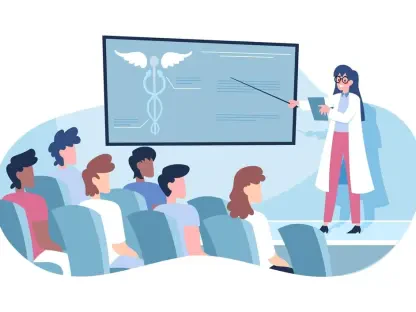The healthcare industry is on the brink of a technological revolution, with IT advancements poised to transform patient care, operational efficiency, and regulatory compliance. As we look ahead to 2025, several key priorities emerge, driven by the need for innovation, security, and patient-centered care. This article delves into the top priorities for healthcare IT, based on comprehensive analysis and industry insights.
Business Impact and ROI
Financial Outcomes and Cost Savings
Healthcare organizations are increasingly focused on the financial impact of IT projects. Cost savings, operational efficiency, and revenue generation are critical metrics for evaluating the success of IT initiatives. By implementing advanced technologies and optimizing existing systems, healthcare providers aim to reduce expenses and improve financial stability. Hospitals and health systems face constant pressure to control costs while delivering high-quality care, and IT solutions play a pivotal role in achieving this balance.
Emerging technologies such as artificial intelligence (AI), machine learning, and automation can significantly reduce administrative burdens. For instance, AI-powered systems can streamline patient scheduling, automate billing processes, and predict patient admissions, leading to more efficient resource allocation. Additionally, the integration of robust financial analytics tools enables healthcare organizations to identify cost-saving opportunities and optimize resource utilization. This focus on financial outcomes not only enhances profitability but also frees up funds for investments in patient care and medical research.
Operational Efficiency
Operational efficiency is another crucial aspect of business impact. Streamlining workflows, automating routine tasks, and enhancing data management can significantly improve the efficiency of healthcare operations. Advances in health IT enable healthcare providers to optimize clinical processes, reduce manual errors, and ensure seamless communication across various departments. This not only reduces costs but also frees up resources for patient care and other critical activities.
For example, the implementation of electronic health record (EHR) systems has revolutionized how patient information is stored, accessed, and shared, improving the speed and accuracy of clinical decision-making. Furthermore, automation of administrative tasks such as appointment scheduling, patient check-ins, and insurance verifications can reduce wait times and enhance the overall patient experience. Robust data management systems ensure that healthcare providers have access to accurate, up-to-date information, facilitating better coordination of care and improving patient outcomes. By focusing on operational efficiency, healthcare organizations can maximize their resources and deliver higher-quality care to patients.
Regulatory Compliance and Risk Mitigation
Adherence to Regulatory Requirements
In its deliberate approach to addressing the complexities of cryptocurrencies, the SEC opted for another delay in its verdict on the spot Ethereum ETF. The extension grants the SEC an opportunity not only to conduct an in-depth examination of Ethereum’s suitability for ETF status but also to source public insight, which could heavily sway the conclusion. This speaks to the SEC’s attentiveness to the nuances of digital assets and their integration into regulatory frameworks, which it does not take lightly. The situation closely parallels the stalling faced by Grayscale, who is also waiting for the green light to transform its Ethereum Trust into a spot ETF, raising questions about the contrasting regulatory processes for Bitcoin and Ethereum.
Regulatory compliance is a top priority for healthcare organizations. With stringent regulations such as HIPAA and GDPR, ensuring data privacy and security is paramount. Healthcare IT systems must be designed to meet these requirements, minimizing the risk of non-compliance and associated penalties. The stakes are high, as breaches in patient data security can lead to significant financial losses and damage to a healthcare organization’s reputation.
To adhere to regulatory requirements, healthcare providers are investing in comprehensive compliance programs that encompass data encryption, access controls, and regular audits. Implementing robust IT governance frameworks ensures that data is handled in accordance with regulatory standards. Additionally, healthcare organizations are increasingly turning to advanced technologies like blockchain to secure patient data and enhance transparency. These measures not only help in achieving compliance but also build trust with patients by assuring them that their sensitive information is protected. As regulations continue to evolve, staying ahead of compliance requirements will be essential for maintaining the integrity and reputation of healthcare organizations.
Cybersecurity Measures
In the digital age, the importance of cybersecurity measures cannot be overstated. Protecting sensitive information from cyber threats is crucial for both individuals and organizations. Ensuring robust security protocols and staying informed about the latest threats can help mitigate risks and safeguard valuable data.
The rise in cyber threats has made cybersecurity a critical concern for healthcare providers. Robust IT security measures, including risk assessments, penetration testing, and incident response plans, are essential to protect sensitive patient data and maintain trust in healthcare systems. Cyberattacks on healthcare institutions can have devastating consequences, compromising patient safety and leading to costly disruptions in service delivery.
Healthcare organizations are adopting a multi-layered approach to cybersecurity, incorporating firewalls, intrusion detection systems, and advanced encryption techniques to safeguard against cyber threats. Regular risk assessments help identify vulnerabilities, while penetration testing simulates attacks to evaluate the effectiveness of security protocols. Developing a comprehensive incident response plan ensures that healthcare providers can quickly and effectively respond to security breaches, minimizing their impact. Additionally, staff training programs on cybersecurity best practices are crucial for fostering a culture of security awareness within healthcare organizations. By prioritizing cybersecurity, healthcare providers can protect patient data, maintain operational continuity, and uphold their commitment to patient safety.
Patient Engagement and Experience
Patient engagement and experience are critical components of effective healthcare delivery, influencing outcomes, satisfaction, and overall well-being. By actively involving patients in their care, healthcare providers can foster better communication, adherence to treatment plans, and trust in the medical system. This collaborative approach also enhances the patient experience, making them feel valued and understood, which can lead to improved health outcomes and increased patient loyalty.
undefined
Patient satisfaction is a key indicator of healthcare quality. IT solutions that improve patient engagement, such as user-friendly patient portals and mobile apps, can enhance the overall patient experience. These tools provide patients with easy access to their health information, appointment scheduling, and communication with healthcare providers. As the healthcare industry shifts toward a more patient-centered model, enhancing patient satisfaction has become a central priority.
Patient portals enable patients to view their medical records, test results, and treatment plans online, promoting transparency and empowering them to take an active role in their healthcare. Mobile apps offer convenient features such as medication reminders, virtual consultations, and secure messaging with healthcare providers, all of which contribute to a more personalized and responsive patient experience. By leveraging these digital tools, healthcare organizations can improve patient satisfaction, reduce readmission rates, and enhance overall health outcomes. Additionally, collecting and analyzing patient feedback through these platforms can help identify areas for improvement and drive continuous enhancements in care delivery.
Consumer Engagement Levels
Consumer engagement is another important aspect of patient-centered care. By leveraging technologies like telehealth and CRM systems, healthcare organizations can foster stronger relationships with patients, leading to better health outcomes and increased patient loyalty. Telehealth platforms enable patients to receive medical consultations and follow-up care remotely, improving access to healthcare services, especially in underserved areas.
Customer Relationship Management (CRM) systems help healthcare providers manage patient interactions, track patient journeys, and tailor care plans based on individual needs and preferences. These systems facilitate proactive communication, reminding patients of upcoming appointments, medication schedules, and preventive care measures. They also allow healthcare organizations to segment patient populations and target specific groups with personalized health interventions. By actively engaging with patients, healthcare providers can build trust, encourage adherence to treatment plans, and promote healthier lifestyles. Emphasizing consumer engagement not only enhances the patient experience but also contributes to better health outcomes and stronger patient-provider relationships.
Technology Integration and Innovation
Adoption of Emerging Technologies
The integration of emerging technologies such as AI, telehealth, and blockchain is transforming healthcare delivery. AI-driven clinical decision support systems, telehealth platforms for remote patient management, and blockchain for secure data exchange are just a few examples of how innovation is enhancing healthcare. These technologies have the potential to revolutionize various aspects of healthcare, from diagnosis and treatment to patient monitoring and data security.
AI algorithms can analyze vast amounts of medical data to provide evidence-based recommendations, assisting healthcare providers in making more accurate and timely clinical decisions. Telehealth platforms enable remote consultations, reducing the need for in-person visits and expanding access to care, particularly in rural and remote areas. Blockchain technology ensures the integrity and security of patient data, preventing unauthorized access and tampering. By adopting these emerging technologies, healthcare organizations can improve the quality of care, enhance operational efficiency, and ensure data privacy and security. The continued integration of innovative solutions will be crucial for driving advancements in healthcare and meeting the evolving needs of patients and providers.
Effective Technology Integration
Effective integration of these technologies is crucial for maximizing their benefits. Healthcare organizations must ensure that new systems are seamlessly integrated with existing IT infrastructure, enabling smooth data flow and interoperability across different platforms. This requires careful planning, robust project management, and collaboration between IT and clinical teams to address potential challenges and ensure successful implementation.
Interoperability is essential for enabling different healthcare systems to communicate and exchange data efficiently. Standards such as Fast Healthcare Interoperability Resources (FHIR) facilitate seamless data exchange, promoting collaboration and coordination among healthcare providers. Additionally, comprehensive training programs for healthcare staff are necessary to ensure they are proficient in using new technologies and fully understand their benefits. By focusing on effective technology integration, healthcare organizations can leverage the full potential of innovative solutions, improve patient care, and enhance operational efficiency. The successful adoption and integration of emerging technologies will be a key driver of progress in the healthcare industry over the coming years.
Scalability and Flexibility
Adaptability of IT Solutions
Scalability and flexibility are essential for future-ready healthcare IT systems. As healthcare needs evolve, IT solutions must be adaptable to accommodate new requirements and technologies. This includes scalable cloud-based systems, modular software architectures, and flexible data management frameworks. Healthcare providers need IT solutions that can grow with their organizations and readily adapt to changing industry demands.
Cloud-based systems offer the advantage of scalability, allowing healthcare organizations to expand their IT infrastructure as needed without significant upfront investments. These systems provide flexibility in data storage, processing, and access, enabling healthcare providers to efficiently manage large volumes of patient data. Modular software architectures allow for the incremental addition of functionalities, ensuring that healthcare IT systems remain up-to-date with the latest advancements. Flexible data management frameworks facilitate the integration of new data sources and support advanced analytics, driving data-driven decision-making. By investing in adaptable IT solutions, healthcare organizations can ensure they are well-equipped to meet future challenges and opportunities.
Long-Term Sustainability
Long-term sustainability is another key consideration. Healthcare organizations must invest in IT solutions that are not only scalable but also sustainable in the long run. This involves choosing technologies that can grow with the organization and continue to deliver value over time. Sustainable IT solutions minimize resource consumption, reduce environmental impact, and ensure cost-effectiveness.
Green IT initiatives focus on incorporating environmentally friendly practices into healthcare IT systems. This includes implementing energy-efficient data centers, reducing electronic waste through recycling programs, and utilizing virtualization technologies to optimize hardware use. Additionally, healthcare organizations are increasingly adopting sustainable procurement practices, selecting vendors that prioritize environmental responsibility. By prioritizing long-term sustainability, healthcare providers can reduce their environmental footprint, achieve cost savings, and contribute to broader sustainability goals. Sustainable IT solutions not only benefit the environment but also enhance the overall resilience and efficiency of healthcare organizations.
Client Satisfaction and Relationship Strength
Client satisfaction and building strong relationships are crucial objectives for businesses seeking long-term success. Companies that prioritize understanding and meeting client needs tend to develop loyal customer bases and gain a competitive edge in their industry. Strong relationships with clients often lead to repeat business, positive word-of-mouth referrals, and increased trust. Thus, investing in customer service, regular communication, and personalized solutions can significantly enhance client satisfaction and strengthen relationships.
undefined
Client satisfaction is a critical measure of success for healthcare IT projects, as ensuring that IT solutions meet the needs and expectations of healthcare providers is essential for building strong, long-term relationships. This includes providing excellent customer support, ongoing training, and regular system updates. Satisfied clients are more likely to continue working with advisory firms and recommend their services to others.
Effective communication is key to achieving high levels of client satisfaction. Regular check-ins, feedback surveys, and transparent reporting help ensure that clients are aware of project progress and any challenges encountered. Providing comprehensive training programs and resources empowers healthcare staff to use IT systems effectively, maximizing their benefits. Additionally, responsive and knowledgeable customer support is crucial for addressing issues promptly and maintaining client trust. By prioritizing client satisfaction, advisory firms can foster strong partnerships, drive successful project outcomes, and support the long-term success of healthcare organizations.
Potential for Long-Term Partnerships
Strong client-advisory firm relationships are vital for the success of healthcare IT initiatives. By fostering trust and collaboration, advisory firms can help healthcare organizations navigate the complexities of IT implementation and achieve their strategic goals. Long-term partnerships enable advisory firms to gain a deep understanding of their clients’ needs, challenges, and goals, leading to more tailored and effective solutions.
Building long-term partnerships requires a commitment to ongoing support and continuous improvement. Advisory firms must stay abreast of industry trends, emerging technologies, and regulatory changes to provide relevant and timely guidance. Regularly reviewing and updating IT strategies ensures that healthcare organizations remain competitive and responsive to evolving market demands. Collaborative problem-solving and a shared focus on achieving strategic objectives strengthen the bonds between advisory firms and their clients. By investing in long-term partnerships, healthcare organizations can benefit from sustained support, innovative solutions, and a trusted advisor to guide them through the ever-evolving healthcare IT landscape.
Cybersecurity and Compliance
Risk Assessment and Penetration Testing
Identifying and addressing vulnerabilities in IT systems is crucial for maintaining cybersecurity. Regular risk assessments and penetration testing can help healthcare organizations identify potential threats and implement effective security measures to mitigate risks. These proactive measures are essential for protecting sensitive patient data and ensuring the integrity of healthcare IT systems.
Risk assessments involve evaluating IT systems, processes, and policies to identify weaknesses and areas of improvement. Penetration testing simulates cyberattacks to test the effectiveness of security protocols and identify vulnerabilities that could be exploited by malicious actors. By conducting these assessments regularly, healthcare organizations can stay ahead of potential threats and continuously enhance their cybersecurity posture. Implementing strong access controls, encryption, and network security measures further bolsters defenses against cyber threats. Additionally, developing and regularly updating incident response plans ensures that healthcare providers are prepared to respond swiftly and effectively to security breaches, minimizing their impact and ensuring continuity of care.
Ensuring Data Privacy
Ensuring data privacy is a top priority for healthcare organizations. Compliance with regulations such as HIPAA and GDPR is essential to protect patient data and maintain trust. Implementing robust data privacy measures, including encryption and access controls, is critical for safeguarding sensitive information. Data breaches and unauthorized access to patient data can have severe consequences, including legal penalties, financial losses, and reputational damage.
Encryption ensures that data is securely transmitted and stored, preventing unauthorized access even if data is intercepted or accessed by malicious actors. Access controls restrict data access to authorized personnel only, minimizing the risk of internal breaches. Regular audits and monitoring help ensure compliance with data privacy regulations and identify any potential vulnerabilities. Additionally, educating healthcare staff on data privacy best practices and the importance of protecting patient information is crucial for fostering a culture of security awareness. By prioritizing data privacy, healthcare organizations can build trust with patients, comply with regulatory requirements, and protect sensitive information from evolving cyber threats.
EHR Optimization and Interoperability
Optimizing Electronic Health Records
Optimizing Electronic Health Records (EHR) systems is essential for efficient healthcare operations. This involves enhancing the functionality of EHR systems, improving data accuracy, and ensuring that healthcare providers can easily access and share patient information. Effective EHR optimization can lead to improved clinical decision-making, streamlined workflows, and better patient outcomes.
Enhancements in EHR systems include the integration of advanced clinical decision support tools, automated alerts, and real-time data analytics. These features help healthcare providers make more informed decisions and identify potential issues early. Improving data accuracy through comprehensive training and standardized data entry protocols minimizes errors and ensures reliable patient records. Additionally, optimizing user interfaces and streamlining navigation make EHR systems more intuitive and user-friendly for healthcare staff. By investing in EHR optimization, healthcare organizations can enhance the efficiency and effectiveness of clinical workflows, reduce administrative burdens, and ultimately improve the quality of patient care.
Achieving Seamless Interoperability
Achieving seamless interoperability between different healthcare IT systems is a key priority. This enables efficient data exchange and collaboration across various healthcare providers, improving patient care and operational efficiency. Interoperability ensures that healthcare providers have access to comprehensive and up-to-date patient information, regardless of where the care is delivered.
Standards such as Fast Healthcare Interoperability Resources (FHIR) play a crucial role in facilitating seamless data exchange between disparate systems. Implementing these standards allows healthcare organizations to integrate various EHR systems, telehealth platforms, and other digital health solutions, ensuring that critical patient data is accessible when needed. Additionally, developing robust data governance frameworks and establishing data-sharing agreements between healthcare providers promote collaboration and enhance care coordination. By prioritizing interoperability, healthcare organizations can break down data silos, improve information flow, and deliver more coordinated and patient-centered care.
Revenue Cycle Management and Strategic HIT Planning
Efficient Revenue Cycle Management
Efficient management of revenue cycles is fundamental for cost control and financial stability. Implementing robust revenue cycle management (RCM) systems can help healthcare organizations streamline billing processes, reduce claim denials, and improve cash flow. Effective RCM ensures that healthcare providers can focus on delivering quality care while maintaining financial health.
RCM systems automate various financial processes, from patient registration and insurance verification to billing and payment collection. These systems provide real-time visibility into the financial status of the organization, enabling healthcare providers to identify bottlenecks, optimize workflows, and address issues promptly. Moreover, advanced analytics tools within RCM systems help identify trends and patterns in billing data, enabling healthcare organizations to make data-driven decisions and improve financial performance. By investing in efficient RCM, healthcare providers can reduce administrative burdens, minimize revenue leakage, and ensure timely reimbursement for services rendered.
Strategic Health Information Technology Planning
Strategic Health Information Technology (HIT) planning is essential for aligning IT initiatives with organizational goals and ensuring the successful implementation of technology solutions. This involves developing a comprehensive IT strategy, prioritizing key projects, and allocating resources effectively. Strategic HIT planning helps healthcare organizations stay competitive, improve patient care, and achieve long-term growth.
A well-defined IT strategy considers the evolving needs of the organization, advances in technology, and changes in regulatory requirements. It outlines clear objectives, timelines, and performance metrics to track progress and measure success. Engaging stakeholders, including clinical staff, IT professionals, and executive leadership, is crucial for gaining buy-in and ensuring alignment with organizational priorities. Regularly reviewing and updating the IT strategy based on feedback and emerging trends helps healthcare organizations remain agile and responsive to changing market dynamics. By prioritizing strategic HIT planning, healthcare organizations can ensure the successful adoption of technology solutions, drive innovation, and achieve their long-term goals.
Conclusion
The healthcare industry stands on the edge of a major technological overhaul, as advancements in IT hold the potential to revolutionize patient care, enhance operational efficiency, and ensure regulatory compliance. By 2025, some pressing priorities in this sector will surface, fueled by the necessity for innovation, heightened security, and a more patient-focused approach to care.
This article delves into the major priorities for healthcare IT by 2025, supported by detailed analysis and insights from the industry. Key areas of focus will likely include the integration of artificial intelligence and machine learning to improve diagnostics and treatment plans, the adoption of electronic health records to streamline information sharing and reduce errors, and the implementation of advanced cybersecurity measures to protect sensitive patient data from breaches.
Moreover, telemedicine and remote monitoring technologies are expected to play a crucial role in increasing access to care, especially in underserved regions. Innovations in wearable devices and mobile health apps will empower patients to actively manage their health, enabling real-time data tracking and personalized healthcare experiences.
In summary, the advancement of healthcare IT by 2025 will center on harnessing cutting-edge technologies to foster a secure, efficient, and patient-centric healthcare ecosystem.









